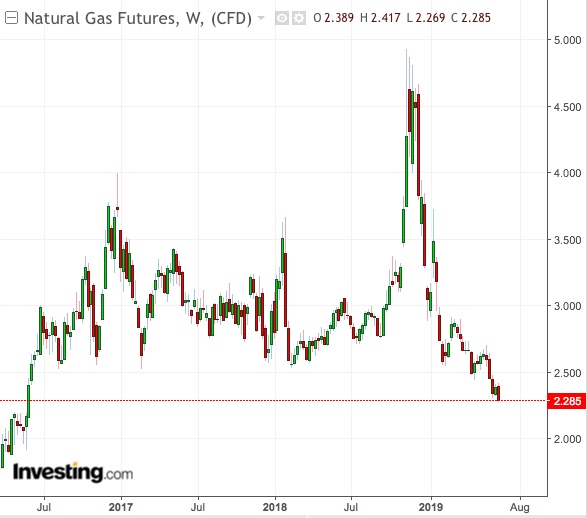It’s crunch time for bears in U.S. natural gas with the question being how much longer the market can defend $2 pricing amid record production of the fuel and a woeful lack of pre-summer cooling demand.

Futures Likely To Extend 3-Year Lows
With bets for weekly storage data on Thursday to show a sixth straight triple-digit build, gas futures on the Henry Hub of the New York Mercantile Exchange look set to make new three-year lows.
But what’s the bottom for the bears to exit and for buying on dips to emerge?
Henry Hub’s front-month gas for July delivery settled at $2.27 per million metric British thermal units on Wednesday, the lowest settlement since May 2016 for a spot gas contract.
Month-to-date, the contract has lost 7%. For 2019 as a whole, the market is down more than 22%.
Dominick Chirichella, director of risk and trading at the Energy Management, said mild weather and growing supply will remain the narrative for at least a few more weeks going forth.
“The current technical trading range boundaries for the contract remain at $2.20/mmBtu on the support side and $2.305/mmBtu on the resistance end.”
Further Price Downside Expected
Investing.com’s Daily Technical Outlook has a more dire prediction. Branding July gas a “Strong Sell”, it projects a downside as low as $2.16. That’s another 5% off from Wednesday’s settlement.
Dan Myers, gas analyst at Houston-based consultancy Gelber & Associates, says picking a bottom was particularly dicey “when the promise of a modest warm-up in late June has not been enough to get the market excited”.
Said Myers:
“Weather models moderate temperatures towards normal in the eastern U.S. going into July. Another factor working against prices this week is the expectation of a large injection in storage.”
Analysts tracked by Investing.com have a consensus for a 107-billion cubic feet (bcf) build in gas storage for the week ended June 14 in data to be issued by the U.S. Energy Information Administration at 10:30 AM ET (14:30 GMT).
That compares with the previous week’s storage growth of 95 bcf.
According to a Reuters analysis, the weather in the week to June 14 was a little cooler than normal last week with 53 cooling degree days (CDDs) versus a 30-year normal of 58 CDDs for the period and 72 CDDs for the same week last year.
CDDs measure the number of degrees a day's average temperature is above 65 Fahrenheit (18 Celsius), and are used to estimate demand to cool homes and businesses.
At a new build of 107 bcf, total stockpiles would stand at just under 2.2 trillion cubic feet, or about 9% below the five-year average and around 10% above the same week a year ago.
The amount of gas in storage has remained below the five-year average since September 2017.
But that may not the case if the current benign weather holds.
Bigger Storage Builds May Be On Their Way
In case, some analysts are calling for even larger injections.
Chirichella is betting on a build of 111 bcf, adding:
“Until there is a sustained heat spell engulfing major parts of the country it will be very challenging for Nat Gas to enter a bullish pattern.”
Myers is thinking of an even higher storage addition of 115 bcf.
He said:
“Although air-conditioning demand will soon climb sufficiently to curb injections below the 100-bcf mark, robust production and lack of sustained heat in late June and early July will still allow storage to grow at a faster rate than the 5-year average as the inventory deficit continues to narrow.”
“Comparing upcoming predictions to last year’s injections is particularly telling as we have yet to see much of the impressive summer heat that crippled storage additions during last refill season.”
